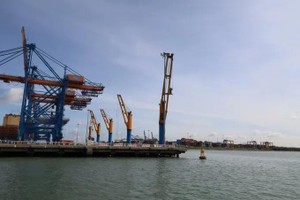
New investors help the VN-Index escalate
After the VN-Index fell to the bottom of 660 points in March when Vietnam officially announced the Covid-19 outbreak, the benchmark currently not only has regained what is lost due to the impact of the pandemic but also climbed by about 11 percent compared to the end of last year. Of which, many large-cap stocks rose sharply by more than 50-100 percent, such as HPG with an increase of 104.2 percent, SSI with 71.9 percent, CTG with 69.4 percent, and STB with 58.7 percent.
One of the conclusive factors for the positive momentum of the stock market over the past time is the cash flow of new investors, especially in the context of low-interest rates and the monetary easing policy, which is still popular in the world, including Vietnam.
From the average liquidity of about VND3 trillion-VND4 trillion per trading session in 2019, in the first ten months of this year, the average trading value on Vietnam's stock market exceeded VND6.2 trillion per trading session, up more than 36 percent year-on-year. From October to December, market liquidity is estimated at more than VND10 trillion per trading session.
During heavily volatile sessions, market liquidity sometimes reached VND14 trillion-VND15 trillion per trading session. Statistics from the Vietnam Securities Depository (VSD) show that only in November domestic investors opened 41,203 new accounts. Of which, the majority were individual investors. In October, domestic investors opened 36,451 new accounts, up more than 5,000 accounts, compared to that in September.
The cash flow continues to pump into the market, showing that the stock channel has become one of the priority investment channels for those with idle money. Securities companies assessed that the force of F0 investors is an abundant resource and plays a crucial role in the development of the Vietnam stock market.
Because F0 investors this year are different from previous generations, they enter the market with a tremendous accumulation of assets, so the cash flow into the market is also extremely large. That is also the reason why although many stock funds in Vietnam continued to withdraw net US$7.7 million in November, the VN-Index still increased by nearly 8.5 percent compared to the end of October.
Low-interest rates support the market
According to experts, many reasons triggered the wave of F0 investors to enter the market this year. The bank interest rates are at low levels, so a large amount of money has flowed from the savings channel to the stock market because these two channels counterbalance each other.
In fact, from the beginning of December this year, the deposit interest rates for over 12-month terms of many major banks have dropped by 0.2 percentage points to 5.6 percent per annum.
At terms from one to six months, the highest interest rate is at 4 percent per annum. Along with the lowest savings interest rates ever, the lending interest rates to buy shares are only from 10 percent to 12 percent per annum, while the lowest levels in the previous years were at 12-14 percent per annum.
Moreover, to attract cash flow, many securities companies have launched margin lending packages with fairly good interest rates, making the VN-Index move positively. From the beginning of December to now, the VN-Index has surpassed the resistance levels of 1,000-1,030 points and is hovering around 1,050 points.
Besides the low-interest rate factor that has supported the stock market, the representative of MASVN Securities Company said that the fiscal and monetary loosening policy is expected to enhance in the coming time. It not only creates a favorable environment for the increase in the value of risky assets in the context that other asset channels, including gold, US dollar, and bank savings, continue to be less attractive but also supports the business picture of enterprises in general in the next year.
The fear of the pandemic has subsided significantly after positive signals about the vaccines for Covid-19. The vaccinations are being conducted in December in many countries. It will be a boost to bring the global economy back on track soon. Along with that, many central banks in the world have reduced interest rates to almost zero percent. There is still room for interest rate cuts in the country. Based on that, investors believe that it is unlikely that interest rates will rise soon. It makes risky assets like stocks remain attractive. Noticeably, with the Kuwaiti market being upgraded to an emerging market, the Vietnam stock market will increase its proportion in the frontier markets basket, becoming the largest market in this index basket. Thereby, the capital flow from the frontier markets funds will pour more into Vietnam’s stock market.
























